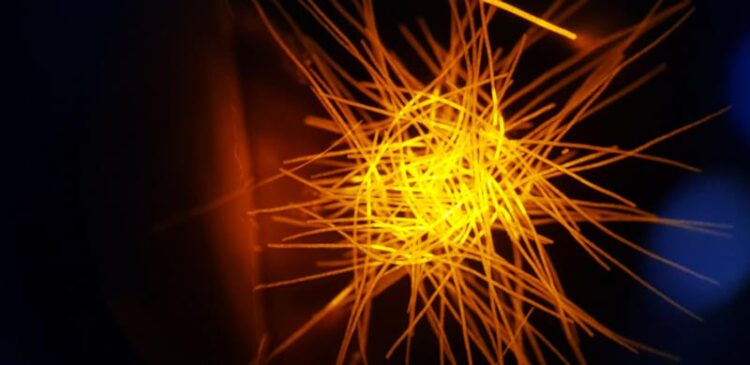Marine diazotrophic bacteria, great little allies against climate change

Colony of the filamentous diazotroph Trichodesmium sp. in surface waters of the South Pacific Ocean. © Sophie Bonnet, IRD
This is the main conclusion of a new study involving ICM-CSIC that proves that these microorganisms contribute directly to the export and sequestration of carbon in the deep ocean.
A new study recently published in The ISME journal in which the Institut de Ciències del Mar (ICM-CSIC) has participated has revealed that diazotrophs, a group of marine cyanobacteria that are able to convert nitrogen gas (N2) from the atmosphere into nutrients for primary producers in the ocean, contribute directly to the carbon export and sequestration on the seafloor.
The results of this work lead by the French Mediterranean Institute of Oceanography (MIO), carried out as part of the TONGA ocean expedition, represent a major paradigm shift, since until now, it was known that these microorganisms “recycled” the CO2 captured from the atmosphere, but the experts were unaware that they also took the CO2 with them when they die and sank, which is the same that the rest of the phytoplankton, i.e., plant plankton, does.
“This process is known as the biological carbon pump, and until now was attributed mainly to phytoplankton, which converts CO2 into organic matter during the photosynthesis. When it dies, the carbon sinks with these microorganisms, storing on the seabed approximately twice as much carbon as is currently found in the atmosphere,” explains Francisco Cornejo, researcher at the ICM-CSIC and one of the authors of the study.
In turn, organisms at higher levels of the marine food web use the same organic matter to survive, thus ensuring the functioning of the entire oceanic system. In fact, thanks to the biological carbon pump, the ocean is considered a carbon sink.
Shifting the paradigm
The results of the study published now have important implications for science because, at present, global biogeochemical models, i.e. the tools used to make predictions about the evolution and fluxes of carbon on the planet, do not take into account the direct contribution of diazotrophs in this process.
“Our results will provide us with a more accurate picture of carbon fluxes in the ocean, which is particularly relevant at a time when climate models predict an expansion of nitrogen-poor zones, where diazotrophs thrive” states the MIO researcher Sophie Bonnet, who initiated this collaborative study.
To carry it out, researchers collected hundreds of samples with sediment traps installed at different depths during a campaign in the South Pacific, which were later analyzed using microscopy, sequencing and DNA quantification techniques.
Thanks to this, they noticed that the particles that sink from the surface to the seabed, in addition to phytoplankton organisms, contain a great quantity and diversity of these diazotrophs. All this has made it possible to quantify, for the first time, the role of these microorganisms in the global biological carbon pump.
For future research, experts will try to delve deeper into the role of diazotrophs in the biological carbon pump, paying special attention to the routes that these microorganisms undergo during their sinking in the different oceanic regions.
Journal: The ISME Journal
DOI: 10.1038/s41396-022-01319-3
Method of Research: Experimental study
Subject of Research: Not applicable
Article Title: Diazotrophs are overlooked contributors to carbon and nitrogen export to the deep ocean
Article Publication Date: 26-Oct-2022
Media Contact
Elena Batalla
Institut de Ciències del Mar (ICM-CSIC)
elenamb@icm.csic.es
Office: 34-676-818-235
Original Source
All latest news from the category: Life Sciences and Chemistry
Articles and reports from the Life Sciences and chemistry area deal with applied and basic research into modern biology, chemistry and human medicine.
Valuable information can be found on a range of life sciences fields including bacteriology, biochemistry, bionics, bioinformatics, biophysics, biotechnology, genetics, geobotany, human biology, marine biology, microbiology, molecular biology, cellular biology, zoology, bioinorganic chemistry, microchemistry and environmental chemistry.
Newest articles

Trotting robots reveal emergence of animal gait transitions
A four-legged robot trained with machine learning by EPFL researchers has learned to avoid falls by spontaneously switching between walking, trotting, and pronking – a milestone for roboticists as well…

Innovation promises to prevent power pole-top fires
Engineers in Australia have found a new way to make power-pole insulators resistant to fire and electrical sparking, promising to prevent dangerous pole-top fires and reduce blackouts. Pole-top fires pose…

Possible alternative to antibiotics produced by bacteria
Antibacterial substance from staphylococci discovered with new mechanism of action against natural competitors. Many bacteria produce substances to gain an advantage over competitors in their highly competitive natural environment. Researchers…





















